The Freedmans - a family of Jewish tailors
Contributed by caroline2 on July 13, 2020
The Freedman Family, Polish Jews who had been living in the Russian Empire, lived here between at least 1891 and 1901 (according to census records). The father, Barnett Freedman, was a tailor, and is variously listed in census records as a master tailor and a military tailor. His wife Bloomah (also called Ester) had nine children, most of whom also worked in the tailoring trade. The children were all born in the East End, while the parents were Russian subjects. The oldest child, Samuel, was born around 1868 when his parents were both 22, so the family must have moved to London sometime in the mid to late 1860s. Before living at New Road they resided around the corner on Old Montague Street, and some time after Barnett's death in 1902 and the 1911 census, his widow and younger children moved to Hackney where they lived on Richmond Road.
Three o'clock walk
Contributed by Mariame_Amouche on May 23, 2018
This is an extract from a longer piece of observational writing about a walk undertaken in 2018 by Mariame Amouche, a first year architecture student at the University of Westminster:
It was at that moment that I realised that the street was filled with a mass of brick built terraces that were nearly identical to one another. I noticed how every domestic building had stairs, providing a boundary that segregated public and private space. Iron railings protectively surrounded each building as if they were guards trying to steer the passing pedestrians away from the domestic premises. Peeling paint loosely clung to the front doors of old homes, juxtaposing the glassy automatic entrance of the high school building. Against the front entrances of houses, worn-out sofas and stained mattresses lingered waiting for their new owners to give them a new home. I was mesmerised by these houses which were still so important to the character of the street, passed down by the communities of the past.

This is an observational sketch made in 2018 by Sebastian Dawber, also a first year architecture student at the University of Westminster.
Carry on walking with Mariame here.
Gloucester Terrace, 11–95 New Road
Contributed by Survey of London on May 9, 2018
Development of the west side of New Road ensued from a decision in 1787 by the London Hospital’s Governors to develop their eight acres west of New Road on building leases. John Robinson, the Hospital’s Surveyor, advertised the prospect of 99-year leases in 1788, and by 1790 Thomas Barnes and John Langley had secured the first and most-westerly lots. Agreements for other sites were made in 1790, principally with Barnes, a bricklayer by origin and now proving himself a prolific builder. He took the whole west side of New Road south of Charlotte (Fieldgate) Street in three lots. At Barnes’s request, Robinson agreed in July 1790 to amend the specification for the storey heights of the intended three-storey and basement New Road houses, adhering to an elevational treatment that had presumably been determined by Robinson. Leases followed on once work was more or less complete.1
Barnes worked his way along the west side of New Road from north to south in 1790–7 building forty houses to form what was known as Gloucester Terrace until the introduction of continuous numbering in 1863. He was given a lease of the block immediately south of Charlotte Street in June 1792, with its houses (77–95 New Road) built or building on 16ft-wide plots. Evidently unfazed by the severe squeeze on credit and inflation that followed the outbreak of war in 1793, Barnes added the next block south as far as William (later Fordham) Street (Nos 49–75), and the southern block down to White Horse Street (Commercial Road) (Nos 11–47) in June 1796, when the houses were built or building. The southerly lease was renegotiated in March 1797 by when the houses were reportedly complete. Barnes had seen the task through efficiently at a difficult time for builders. He was all the same told off for having deviated from the hospital’s plans in places.2
Gloucester Terrace (11–95 New Road) is all but entirely outside the parish of Whitechapel in what was Mile End Old Town. A number of the houses of the 1790s still stand. There was general uniformity, but with variations. No. 43, for example, was apparently always a storey taller than its neighbours. It is otherwise broadly typical, though it and its neighbour at No. 45 were conservatively refronted in the late nineteenth century, copying original door surrounds with vermiculated stone quoins and Coade-stone keystones with mask reliefs. These survive elsewhere and the date 1797 can be seen on the soffit of the keystone at No. 33, another not entirely typical house in that it has a wider plot and a bow at the back.
-
Royal London Hospital Library and Archive (RLHLH), House Committee Minutes (HCM), 15 May 1787, p. 285; 22 April and 1 July 1788, pp. 342,353; 23 Feb, 16 March, 15 June and 13 July 1790, pp. 103, 106, 122,126: RLHLH/F/10/3 ↩
-
RLHLH, HCM, 26 Sept 1797, p. 147: RLHLH/F/10/3: London Metropolitan Archives, Tower Hamlets Commissioners of Sewers ratebooks: Richard Horwood's maps, 1799 and 1813: Metropolitan Board of Works Minutes, 22 May 1863, p. 499 ↩
New Road's formation
Contributed by Survey of London on May 9, 2018
New Road was formed in 1754–6 in close connection with the London Hospital’s
move to the south side of Whitechapel Road in 1752–7. Slightly earlier than
the better-known New Road of 1756–7 (now Marylebone Road and Euston Road), it
shared with its bigger north-westerly sister the attribute of being a bypass
to built-up districts. More particularly, it made eastern Whitechapel
(heretofore ‘town's end’) more accessible from riverside districts, linking
what are now Cable Street and The Highway in the south to Whitechapel Road
across entirely open fields. It more or less followed the line of Civil War
defences, though this might be little more than coincidence. The road was
enabled by an Act of Parliament and overseen by a body of trustees led by
prominent commercial men from riverside districts (Jonathan Eade, a Wapping
ship-chandler, John Shakespear, a Shadwell ropemaker, Joseph Curtis, a Wapping
sea-biscuit maker, Hugh Roberts, a St George-in-the-East brewer, and William
Camden, a Wapping ship-owner and slave-trader), some among them hospital
governors. For these people good access to the hospital presumably mattered
not just for themselves and their families, but also for their workforces.
New Road’s frontages remained largely undeveloped for more than thirty years.
Only the road’s northernmost end lies in Whitechapel parish. The connections
formed there were first exploited for industrial use in the shape of carriage-
making, present by the 1770s. Houses followed in the 1790s, but industry
persisted and transformed, turning predominantly to clothing trades in the
early twentieth century.1
-
Derek Morris and Ken Cozens, London's Sailortown 1600–1800, 2014, p. 19: Derek Morris, Whitechapel: 1600–1800, 2011, p. 53: _An Account of the Rise, Progress and State of the London Hospital, _1775: Royal London Hospital Library and Archive, S/10/1: William Owen, ‘The Ichnography of the Cities of London and Westminster and the Borough of Southwark’, 1757 ↩
Noorul Islam's life in Whitechapel
Contributed by Survey of London on Feb. 5, 2018
Noorul Islam came to Whitechapel in 1974 and spent his working life in the textile industry in and around the area. He has lived on New Road since 1993, and here reflects on his life and the changes he has seen.
“My name is Noorul Islam. I came to this country in 1967 [from Sylhet in East Pakistan]. I was 14 and a half at that time, I came to live at 14 Settles Street in 1974.
It was a five-storey house, and at that time all the Bangladeshis were single people, they didn’t bring their families to this country, and they used to live together in one house… Every room, two person used to share, so 10 [rooms], it would have been 20 [people]… Well, because we were living in one house, this is how we came to know each other. There were one or two person I used to know from my village. [The house] used to be owned by Jewish people, very rich people. They used to collect the rent from the landlord who used to come.
For about two years, I was working for Savoy [hotel]. Then I changed my trade, started working in tailoring, as a machinist. [I worked in] many places. People used to change their job very frequently because it was available. Especially these machinists, they had a great demand there, so you can leave any job and [find another one] all in this area [Whitechapel / Spitalfields].
The Jewish people, they used to own this place. Our Asian people, like Bangladeshis and the Pakistani or Indian people, they used to work for the Jewish people, Jewish firms. The main trade was in the control of the Jewish people. Indian people or the Bangladeshi people used to work directly in the factories or [if] the factory was owned by the Asian people, Bangladeshi people, the supplies used to be [by] Jewish people.
Slowly gradually, these Asian people tried to expand their businesses and tried to do their own, establishing their own businesses and trade slowly, gradually…The Turkish people also started coming in, getting in to this trade. Jewish people, they moved out of this area, slowly. These are the changes I have witnessed.
Working in textiles
[We made] mainly ladies coats, long or short…[The coats would be made for] department stores. The department stores were owned by the rich people.. but cut, makes and trims are the things that used to be done by Asian people. Cuts, makes and trims. This is, to call it shorter, CMT.
I used to work for the factories, especially our own country's people. Then with three partners with me, we established a small tailoring factory [in 1974 on Brick Lane]. We had the material from the other manufacturers. They used to cut it. We used to just bring those materials and sew it and make the shell of it, not complete because we didn't have enough money or enough place. We used to just make the shell of that.
[We] rented a place, and also rented machines from the machine shop. Rented, because we were not able to buy it and own it. I was doing it until 1989. That many years, you know? Then we changed from clothing to leather. Again, we used to work for a Jewish person, big boss. He used to supply the leather and we used to cut, make and trim.
Finding adequate housing
In 1974, we moved [into a house] just behind the little bridge across Brick Lane. They were crammed houses, very old, and they were cheap. With rats-- I'm sorry to say, big, big rats. I really became ill because of that. I did get TB [in 1980]. I was treated in Mile End Hospital for a couple of years, you know? I stayed in the hospital for three weeks. They planned to send me outside of London for recovery, I said no, please do not send me outside because I will get no visitor, no family, no friends. So they said ok as you are living on your own.
I got an accommodation from Newland Housing Trust [in 1980]. They provided me the property, a bedsitter apartment, number 11 Albert Cottages. They refurbished it. I was there for one year, suffering because of that very poor living conditions. I'm describing everything [to show what] this community went through, so you get this picture.
From there, I bring my wife. Newland Housing Trust re-housed me in Folgate Street. It was in 1980. Then I started getting children. I got three daughters, that was a one-bedroom flat. We were overcrowded, so they offered me another property in same street, but it was a house, a three-storey house, three bedrooms. From 1980 till 1993 I was there. Then 1993, again it was overcrowded because I have many children. Seven children I have.
Seven children. Three bedroom house. Not enough. They got me this five bedroom house [on New Road]. It was five story. ..It’s quite good to live in. Beautiful. Ground floor, the living room, one bedroom. In the basement, only the kitchen, the dining, the washroom and one lovely sink with the shower. First floor, two bedrooms. Second floor, two bedrooms and one bathroom and toilet. Garden at the back. Garden at the front. [When we moved in it was] refurbished. I think it used to be a business place, the whole building. I think it was a tailoring business.
…
[My children] live around [here]. Only one of my daughter got married in Birmingham. Unfortunately she passed away about six years ago.
Well in 1989, I stopped my business. Then started to work for other people, same trade but for other people. And I did work up to 2004 in tailoring and then I started working for a firm called "A1 Furniture" that is owned by a Jewish person. I worked for them up to 2012..[then] got redundancy and then I didn't work after that.
About changes in Whitechapel
Well I have seen many changes [in Whitechapel] for example there used to be so many slum houses, very poor education. Because Bangladeshis [were an] ethnic minority, there was not much care about these people. That's what the community leaders was fighting for it. Why this racism is going on, all these good houses is being given to the White people. ..All these issues they used to [raise].
[There was] racial harassment as well. Skinheads in 1974, 75. In 1973 Brick Lane used to be attacked by groups of youths. They used to come every Sunday. Every Sunday they used to come and they used to stab people in the street. Punching people, many sorts of attacks. These poor Bangladeshi people, what they can do? The empty milk bottles in crates they used to throw. These sort of things used to go on, and all these fights you know was going on.
I forgot what year it was, the Bangladesh community started thinking "we should do something about it to get our own rights." They decided to put one candidate, independent candidate for the councillor. [In Spitalfields especially, behind] every single door [lived] Bangladeshi people, every single, hardly maybe one or two people [from] different communities. White is very hard to see in that area. …So they decided to put one [independent] candidate it was 1984 or 85, we put one Asian candidate, and the vote was hundred percent vote into that box, even Labour party failed because every single Bangladeshi vote [went] to that candidiate. Now the authority was concerned, "Oh, we were thinking to put them in one place and give them poor education." Whatever the racism was there, who knows.
Now they start giving people support in Stepney Green, Mile End, Bow, Docklands. They started spreading [people out] and they started bringing other community people into the area, because of the racism..
So this is how Whitechapel changed, especially housing. They said no inch should be left without being developed, every single inch of the city is developed, and this is what is taking place at least I think.
[My children] They are staying here. They're born here, brought up here. Well for a religious person they got educated in that environment, they are born here and their mentality, their community everything is [here].”
Noorul Islam was in conversation with Shahed Saleem on 17.08.17 on New Road
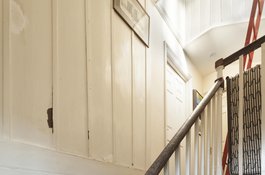
Staircase, 43 New Road, December 2017
Contributed by Derek Kendall
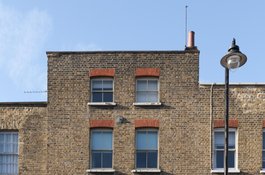
43 New Road, December 2017
Contributed by Derek Kendall
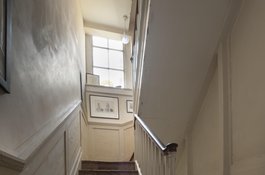
Staircase, 43 New Road, December 2017
Contributed by Derek Kendall
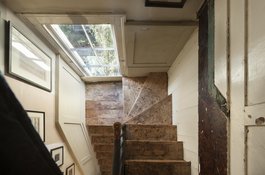
Staircase from above, 43 New Road, December 2017
Contributed by Derek Kendall
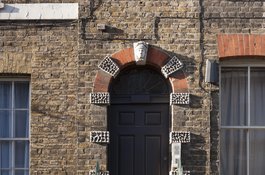
View to entrance, 43 New Road, December 2017
Contributed by Derek Kendall
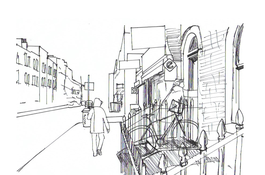
Entrance to a house on New Road
Contributed by Sebastian_Dawber